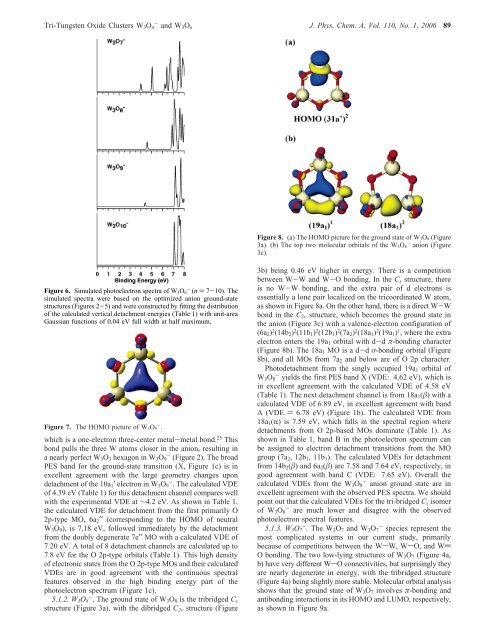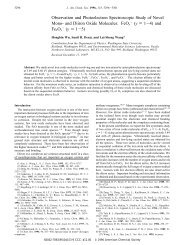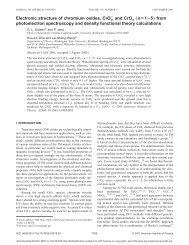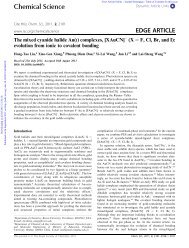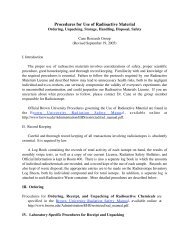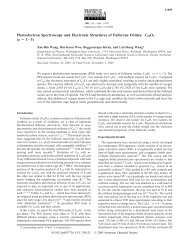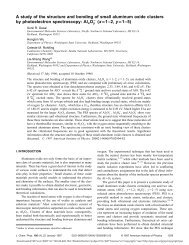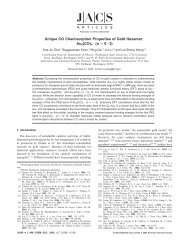88 J. Phys. Chem. A, Vol. 110, No. 1, 2006 Huang et al.Figure 5. Optimized structures <strong>and</strong> <strong>the</strong>ir relative energies for W 3O 10<strong>and</strong> W 3O 10- . The bond lengths are in angstroms <strong>and</strong> bond angles indegrees.converged to <strong>the</strong> same structure. The ground state <strong>of</strong> W 3 O 9 wasfound to be closed shell with D 3h ( 1 A 1 ′) symmetry. Each tungstenatom is tetrahedrally coordinated with two terminal <strong>and</strong> twobridging O atoms (Figure 2a). This is basically consistent withthat identified by Sun et al. 29 at BPW91, except that <strong>the</strong> structure<strong>of</strong> Sun et al. possesses lower symmetry (C 3V ). The WsO t <strong>and</strong>WsO b bond lengths are 1.706 <strong>and</strong> 1.908 Å, close to thoseexpected for WdO double <strong>and</strong> WsO single bonds, respectively.The ∠WO b W bond angle is 137.1°, much larger than <strong>the</strong> ∠O b -WO b angle <strong>of</strong> 102.9°.The ground state <strong>of</strong> W 3 O 9- was found to be a doublet withD 3h ( 2 A 1 ′) symmetry (Figure 2b), similar to that for <strong>the</strong> neutral.The W-O t <strong>and</strong> W-O b bond lengths are 1.724 <strong>and</strong> 1.923 Å,respectively, only slightly longer than those in <strong>the</strong> neutralspecies. However, <strong>the</strong> ∠WO b W <strong>and</strong> ∠O b WO b bond angleschange significantly. The ∠WO b W bond angle is 116.2°,decreased by about 21° relative to that <strong>of</strong> neutral W 3 O 9 , whereas<strong>the</strong> ∠O b WO b bond angle increases by about 21°, so that <strong>the</strong>W 3 O 3 ring is almost a perfect hexagon. 25 This large geometrychange between <strong>the</strong> anion <strong>and</strong> neutral ground state is consistentwith <strong>the</strong> broad ground-state b<strong>and</strong> observed in <strong>the</strong> photoelectronspectrum <strong>of</strong> W 3 O 9- (Figure 1c). It should be mentioned that<strong>the</strong>re are o<strong>the</strong>r low-lying isomers for W 3 O 9 - that are close inenergy to <strong>the</strong> D 3h structure at <strong>the</strong> DFT level. Fur<strong>the</strong>r <strong>the</strong>oreticalcalculations with more sophisticated methods may be necessaryto resolve <strong>the</strong> true ground state <strong>of</strong> W 3 O 9 - .4.2. Oxygen-Deficient Cluster: W 3 O 8 <strong>and</strong> W 3 O 8 - . Westarted <strong>the</strong> structural searches for <strong>the</strong> O-deficient clusters byremoving O atoms from <strong>the</strong> ground state <strong>of</strong> <strong>the</strong> stoichiometricW 3 O 9 cluster. We located two isomers for neutral W 3 O 8 . Theground state <strong>of</strong> W 3 O 8 was found to be closed shell with C s ( 1 A′)symmetry (Figure 3a), which can be viewed as removing oneterminal O atom from <strong>the</strong> D 3h W 3 O 9 . The o<strong>the</strong>r isomer withC 2V ( 1 A 1 ) symmetry (Figure 3b) is 0.46 eV higher in energy<strong>and</strong> is derived from removing one bridging O atom from W 3 O 9 .In <strong>the</strong> anion, <strong>the</strong> C 2V structure (Figure 3c) was found to be <strong>the</strong>ground state, becoming more stable than <strong>the</strong> C s isomer (Figure3d) by 0.12 eV. The structures <strong>of</strong> <strong>the</strong> two W 3 O 8 - isomers arevery similar to <strong>the</strong>ir corresponding neutrals with very littlegeometrical changes, consistent with <strong>the</strong> relatively sharp PESfeatures observed for W 3 O 8 - (Figure 1b).4.3. Oxygen-Deficient Cluster: W 3 O 7 <strong>and</strong> W 3 O 7 - . Weperformed an extensive search <strong>of</strong> <strong>the</strong> potential energy surfaces<strong>of</strong> W 3 O 7 <strong>and</strong> W 3 O 7 - using <strong>the</strong> two isomers <strong>of</strong> W 3 O 8 <strong>and</strong> W 3 O 8-(Figure 3) as our starting points. We were able to locate fourlow-lying isomers, as shown in Figure 4. The ground state <strong>of</strong>neutral W 3 O 7 is C s ( 1 A′) (Figure 4a), which is formed fromremoving two terminal O atoms on two different W sites from<strong>the</strong> neutral W 3 O 9 . The second low-lying isomer (Figure 4b) alsowith C s symmetry is only 0.08 eV higher in energy <strong>and</strong> isoriginated from removing one terminal <strong>and</strong> one bridging O atomfrom two different W sites <strong>of</strong> W 3 O 9 . The third isomer <strong>of</strong> W 3 O 7(Figure 4c), 0.64 eV higher in energy, is formed by removingone terminal <strong>and</strong> one bridging O atom from <strong>the</strong> same W atom<strong>of</strong> W 3 O 9 . The W 3 O 7 isomer formed by removing two bridgingO atoms from W 3 O 9 is much higher in energy by 1.47 eV(Figure 4d).For <strong>the</strong> W 3 O 7 - anion, <strong>the</strong> ground state is <strong>the</strong> dibridged C s( 2 A′) structure (Figure 4e), corresponding to <strong>the</strong> second lowlyingisomer <strong>of</strong> <strong>the</strong> neutral cluster. The second isomer <strong>of</strong> W 3 O 7 - ,only 0.10 eV higher in energy, corresponds to <strong>the</strong> ground state<strong>of</strong> <strong>the</strong> neutral. The third (Figure 4g) <strong>and</strong> fourth (Figure 4h)isomers <strong>of</strong> <strong>the</strong> anion are similar to <strong>the</strong> corresponding neutralisomers <strong>and</strong> are higher in energy by 0.45 <strong>and</strong> 0.52 eV above<strong>the</strong> ground state, respectively.4.4. Oxygen-Rich Clusters: W 3 O 10 <strong>and</strong> W 3 O 10 - . We foundtwo isomers each for W 3 O 10 <strong>and</strong> W 3 O 10 - , as shown in Figure5. The ground state <strong>of</strong> W 3 O 10 possesses C 1 ( 1 A) symmetry(Figure 5a) <strong>and</strong> can be viewed as replacing a terminal O atomin W 3 O 9 by an O 2 unit. A triplet isomer without <strong>the</strong> O 2 unit is1.25 eV higher in energy (Figure 5b). This isomer, however,becomes <strong>the</strong> ground state for <strong>the</strong> W 3 O 10 - anion (Figure 5c),whereas <strong>the</strong> isomer with <strong>the</strong> O 2 unit is significantly higher by1.57 eV in <strong>the</strong> anion (Figure 5d).5. Discussion5.1. Comparisons between Experimental <strong>and</strong> TheoreticalResults <strong>and</strong> Interpretation <strong>of</strong> <strong>the</strong> Photoelectron Spectra.Photodetachment involves removal <strong>of</strong> electrons from occupiedmolecular orbitals (MOs) <strong>of</strong> <strong>the</strong> anions. The final states <strong>of</strong> <strong>the</strong>electron detachment are <strong>the</strong> electronic ground <strong>and</strong> excited states<strong>of</strong> <strong>the</strong> corresponding neutrals. The differences between <strong>the</strong>higher-binding energy b<strong>and</strong>s <strong>and</strong> <strong>the</strong> lowest-binding energy b<strong>and</strong>in an anion photoelectron spectrum represent <strong>the</strong> excitationenergies <strong>of</strong> <strong>the</strong> neutral cluster. The simulated spectra <strong>of</strong> <strong>the</strong>whole W 3 O - n (n ) 7-10) series are shown in Figure 6. All<strong>the</strong> calculated VDEs are given in Table 1 along with <strong>the</strong>experimental data.Within <strong>the</strong> one-electron formalism, each occupied MO for aclosed-shell anion will generate a single PES b<strong>and</strong> with <strong>the</strong>associated vibrational structures governed by <strong>the</strong> Franck-Condon principle. However, all <strong>the</strong> W 3 O n- anions are open shellwith a single unpaired electron in <strong>the</strong>ir lowest energy structures.In <strong>the</strong>se cases, detachment from a fully occupied MO wouldresult in two detachment channels due to <strong>the</strong> removal <strong>of</strong> ei<strong>the</strong>r<strong>the</strong> spin-down (β) or <strong>the</strong> spin-up (R) electrons, giving rise totriplet (T) <strong>and</strong> singlet (S) final states, respectively, as given inTable 1.5.1.1. W 3 O 9- . The valence electron configuration <strong>of</strong> W 3 O 9( 1 A 1 ′, D 3h ) is (6e′′) 4 (12e′) 4 (7e′′) 4 (6a 2 ′′) 2 , all <strong>of</strong> which areprimarily O 2p-based orbitals. In W 3 O - 9 <strong>the</strong> extra electron enters<strong>the</strong> 10a 1 ′ LUMO <strong>of</strong> W 3 O 9 , resulting in a doublet ( 2 A 1 ′) statefor <strong>the</strong> anion. The calculated spin densities indicate that <strong>the</strong>extra electron is equally shared by <strong>the</strong> three W atoms. The threedimensionalcontour <strong>of</strong> <strong>the</strong> 10a 1 ′ MO is shown in Figure 7,
<strong>Tri</strong>-<strong>Tungsten</strong> <strong>Oxide</strong> Clusters W 3 O n - <strong>and</strong> W 3 O n J. Phys. Chem. A, Vol. 110, No. 1, 2006 89Figure 8. (a) The HOMO picture for <strong>the</strong> ground state <strong>of</strong> W 3O 8 (Figure3a). (b) The top two molecular orbitals <strong>of</strong> <strong>the</strong> W 3O 8- anion (Figure3c).Figure 6. Simulated photoelectron spectra <strong>of</strong> W 3O n- (n ) 7-10). Thesimulated spectra were based on <strong>the</strong> optimized anion ground-statestructures (Figures 2-5) <strong>and</strong> were constructed by fitting <strong>the</strong> distribution<strong>of</strong> <strong>the</strong> calculated vertical detachment energies (Table 1) with unit-areaGaussian functions <strong>of</strong> 0.04 eV full width at half maximum.Figure 7. The HOMO picture <strong>of</strong> W 3O 9- .which is a one-electron three-center metal-metal bond. 25 Thisbond pulls <strong>the</strong> three W atoms closer in <strong>the</strong> anion, resulting ina nearly perfect W 3 O 3 hexagon in W 3 O 9 - (Figure 2). The broadPES b<strong>and</strong> for <strong>the</strong> ground-state transition (X, Figure 1c) is inexcellent agreement with <strong>the</strong> large geometry changes upondetachment <strong>of</strong> <strong>the</strong> 10a 1 ′ electron in W 3 O 9 - . The calculated VDE<strong>of</strong> 4.39 eV (Table 1) for this detachment channel compares wellwith <strong>the</strong> experimental VDE at ∼4.2 eV. As shown in Table 1,<strong>the</strong> calculated VDE for detachment from <strong>the</strong> first primarily O2p-type MO, 6a 2 ′′ (corresponding to <strong>the</strong> HOMO <strong>of</strong> neutralW 3 O 9 ), is 7.18 eV, followed immediately by <strong>the</strong> detachmentfrom <strong>the</strong> doubly degenerate 7e′′ MO with a calculated VDE <strong>of</strong>7.20 eV. A total <strong>of</strong> 8 detachment channels are calculated up to7.8 eV for <strong>the</strong> O 2p-type orbitals (Table 1). This high density<strong>of</strong> electronic states from <strong>the</strong> O 2p-type MOs <strong>and</strong> <strong>the</strong>ir calculatedVDEs are in good agreement with <strong>the</strong> continuous spectralfeatures observed in <strong>the</strong> high binding energy part <strong>of</strong> <strong>the</strong>photoelectron spectrum (Figure 1c).5.1.2. W 3 O 8 - . The ground state <strong>of</strong> W 3 O 8 is <strong>the</strong> tribridged C sstructure (Figure 3a), with <strong>the</strong> dibridged C 2V structure (Figure3b) being 0.46 eV higher in energy. There is a competitionbetween W-W <strong>and</strong> W-O bonding. In <strong>the</strong> C s structure, <strong>the</strong>reis no W-W bonding, <strong>and</strong> <strong>the</strong> extra pair <strong>of</strong> d electrons isessentially a lone pair localized on <strong>the</strong> tricoordinated W atom,as shown in Figure 8a. <strong>On</strong> <strong>the</strong> o<strong>the</strong>r h<strong>and</strong>, <strong>the</strong>re is a direct W-Wbond in <strong>the</strong> C 2V structure, which becomes <strong>the</strong> ground state in<strong>the</strong> anion (Figure 3c) with a valence-electron configuration <strong>of</strong>(6a 2 ) 2 (14b 2 ) 2 (11b 1 ) 2 (12b 1 ) 2 (7a 2 ) 2 (18a 1 ) 2 (19a 1 ) 1 , where <strong>the</strong> extraelectron enters <strong>the</strong> 19a 1 orbital with d-d π-bonding character(Figure 8b). The 18a 1 MO is a d-d σ-bonding orbital (Figure8b), <strong>and</strong> all MOs from 7a 2 <strong>and</strong> below are <strong>of</strong> O 2p character.Photodetachment from <strong>the</strong> singly occupied 19a 1 orbital <strong>of</strong>W 3 O 8 - yields <strong>the</strong> first PES b<strong>and</strong> X (VDE: 4.62 eV), which isin excellent agreement with <strong>the</strong> calculated VDE <strong>of</strong> 4.58 eV(Table 1). The next detachment channel is from 18a 1 (β) with acalculated VDE <strong>of</strong> 6.89 eV, in excellent agreement with b<strong>and</strong>A (VDE ) 6.78 eV) (Figure 1b). The calculated VDE from18a 1 (R) is 7.59 eV, which falls in <strong>the</strong> spectral region wheredetachments from O 2p-based MOs dominate (Table 1). Asshown in Table 1, b<strong>and</strong> B in <strong>the</strong> photoelectron spectrum canbe assigned to electron detachment transitions from <strong>the</strong> MOgroup (7a 2 , 12b 1 , 11b 1 ). The calculated VDEs for detachmentfrom 14b 2 (β) <strong>and</strong> 6a 2 (β) are 7.58 <strong>and</strong> 7.64 eV, respectively, ingood agreement with b<strong>and</strong> C (VDE: 7.65 eV). Overall <strong>the</strong>calculated VDEs from <strong>the</strong> W 3 O 8 - anion ground state are inexcellent agreement with <strong>the</strong> observed PES spectra. We shouldpoint out that <strong>the</strong> calculated VDEs for <strong>the</strong> tri-bridged C s isomer<strong>of</strong> W 3 O 8 - are much lower <strong>and</strong> disagree with <strong>the</strong> observedphotoelectron spectral features.5.1.3. W 3 O 7 - . The W 3 O 7 <strong>and</strong> W 3 O 7 - species represent <strong>the</strong>most complicated systems in our current study, primarilybecause <strong>of</strong> competitions between <strong>the</strong> WsW, WsO, <strong>and</strong> WdO bonding. The two low-lying structures <strong>of</strong> W 3 O 7 (Figure 4a,b) have very different WsO connectivities, but surprisingly <strong>the</strong>yare nearly degenerate in energy, with <strong>the</strong> tribridged structure(Figure 4a) being slightly more stable. Molecular orbital analysisshows that <strong>the</strong> ground state <strong>of</strong> W 3 O 7 involves π-bonding <strong>and</strong>antibonding interactions in its HOMO <strong>and</strong> LUMO, respectively,as shown in Figure 9a.


